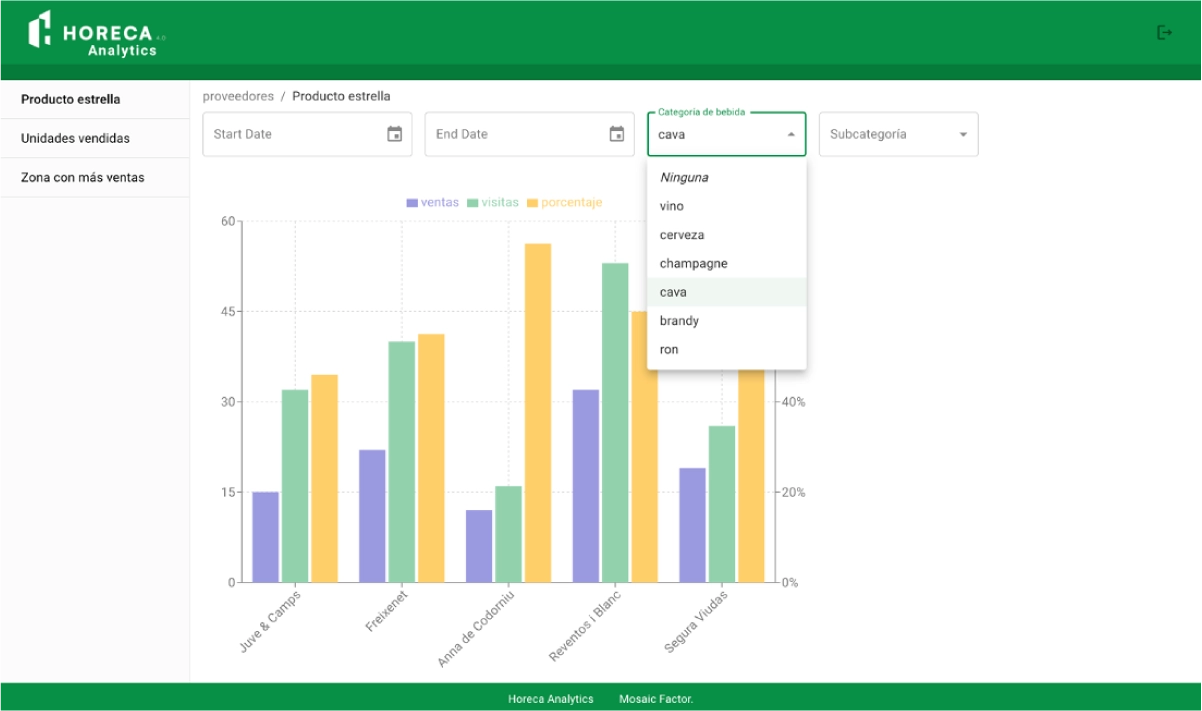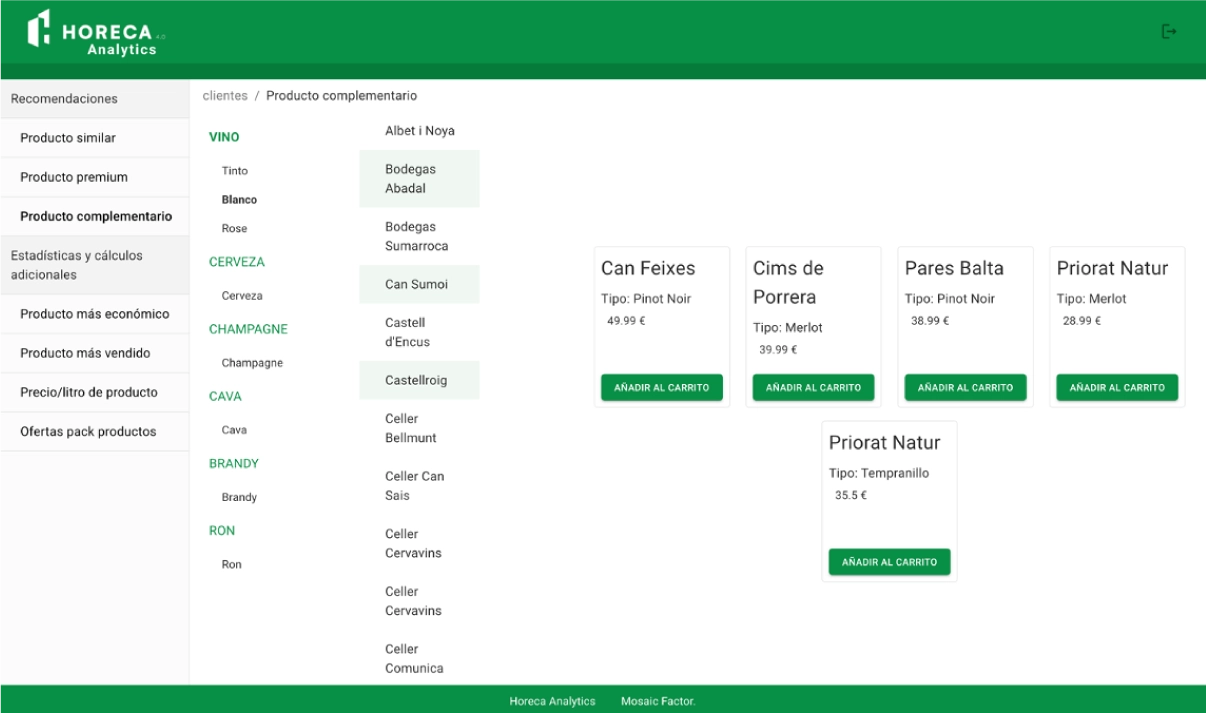B2B Marketplace data mining and platform dev.
Client
Funded by the Spanish Government

Partners
The problem
The HORECA channel (Hotels, Restaurants, and Cafeterias) requires and purchases a multitude of products, which generally means each company needs multiple suppliers. It is a highly fragmented sector, mostly made up of SMEs, and has been greatly affected by closures and restrictions due to the pandemic. Because of the characteristics of the companies in the channel, their access to the digital transformation of their value chains, the related benefits, and the ability to process aggregated sector data have been compromised.
At a time when marketplaces are leading B2C (Business to Consumer) online sales in most countries, and when the B2B (Business to Business) world is generating more business than B2C, there are still many supplier companies in the HORECA channel, both manufacturers and distributors, that do not have access to a B2B platform to channel sales and manage their customer relationships online.
Moreover, the companies within HORECA are the actors that directly interact with end consumers. They have access to valuable information about their consumption patterns, preferences, and product knowledge, which is of great value to the rest of the supply chain, including distributors and especially manufacturers.
HORECA B2B marketplace interest for companies:
-
- COVID-19 has reduced commercial contact, and the sector is also undergoing digitalization, so end companies are seeking B2B online stores that allow them to view catalogs, compare prices, make purchases, and reduce their operating costs.
- Large brands and major distributors already have or will soon launch their B2B platforms, but there are thousands of SMEs that do not have the financial capacity to invest, promote, and launch a B2B platform, thus losing competitiveness.
- The use of platform data will allow for sector comparisons, promoting best practices, providing customer feedback, and enabling campaigns to increase sales.
This environment would allow brands and distributors to obtain valuable aggregated information, in addition to providing a single point of contact and purchasing for their customers and creating a more efficient channel for buying and selling and the associated operations.
The goal of this project is to launch a fully functional prototype in a simulated environment. It will involve the participation of three partner companies from the Clúster Digital interested in launching this new business model and innovating in terms of data visualisation and integration, with the support of the Clúster Innovi, which brings together many suppliers from the HORECA sector.
To achieve this, it is necessary to define a data exploitation model and a potential business model that makes it feasible to bring it to reality, with the aim of accelerating the digitisation of such a strategic sector, making it more resilient and efficient, and thus maintaining its competitiveness.
The solution
The project develops a Marketplace prototype with a series of functionalities useful for the different stakeholders of the project.
MOSAIC FACTOR has been responsible of the data mining task, developing the functionalities of the platform as well as the software architecture of the system, both Back End and Front End.
The functionalities of the system are described below:
- Functionalities based on intelligent models: Various solution options have been studied, considering the types of users present on the Horeca 4.0 platform, its products, and the attributes that describe those products, among other parameters. Ultimately, two solutions have been chosen with the goal of providing recommendations to purchasing users:
- Similar Product: This functionality involves detecting and recommending similar products using product attribute information in a suitable clustering algorithm. Once a product has been viewed or purchased, the solution checks other products within the same cluster and displays the top three products detected according to certain ranking criteria.
- Complementary Product: This functionality detects and recommends complementary products based on the transactions of all users, often purchased together to meet joint demand. It is independent of the product group, meaning different products from different groups can be purchased together.
- Functionalities derived from statistics and data calculations: To complement the two previous solutions and provide greater insight and value from the data generated on the Horeca 4.0 platform (or, at this prototype stage of the platform, from synthetically generated data for the four available products: wines, beers, sparkling wines, and spirits), a series of functionalities has been selected based on the user type. These functionalities can help users make better decisions or seize opportunities.
We developed the following:
- Purchasing user feature (divided into general, mid-tier, and premium groups):
- Identify the cheapest product based on one of the available attributes from the synthetic data (or from the platform if it were functional).
- For example, if the user wants the cheapest product based on the type of beverage, they will see the cheapest product in each category.
- Visualize the best-selling product based on one of the available attributes in the synthetic data.
- Calculate the price per liter of a product.
- View the best offers for a specific number of bottles of wine the buyer needs.
- Producer/distributor user feature:
- Identify the region where they have sold the most products and the quantity sold, based on one of the available attributes (as before).
- View the best-selling product (with a filter to select between annual sales or sales during specific periods, such as Christmas, Easter, etc.).
- View the product with the most visits, with the same filter as above.
- See the percentage of sales per visit for a product (e.g., product X is sold 80% of the times it is visited by a customer).
- Display a graph showing the quantity of wine sold over a period of time (with the option to filter by total wine sales or by specific types of wine).
At a technological level, the data mining solutions are based on the following algorithms:
3. Similar product recommendation: Clustering algorithm

4. Complementary product recommendation: Association Rule Mining

Data
As there was no real data available yet from the providers, MOSAIC have created synthetic data to be able to develop the functionalities required for this project. These datasets have the following parameters:

Results
Front-end: https://horeca-analytics.apps.mosaicfactor.es/
Some examples of the functionalities:
– Star product:

– Areas with more sells:

– Interface for customers:


– Complementary product recommendation:

– Pack of products (offers):

Imagery






























